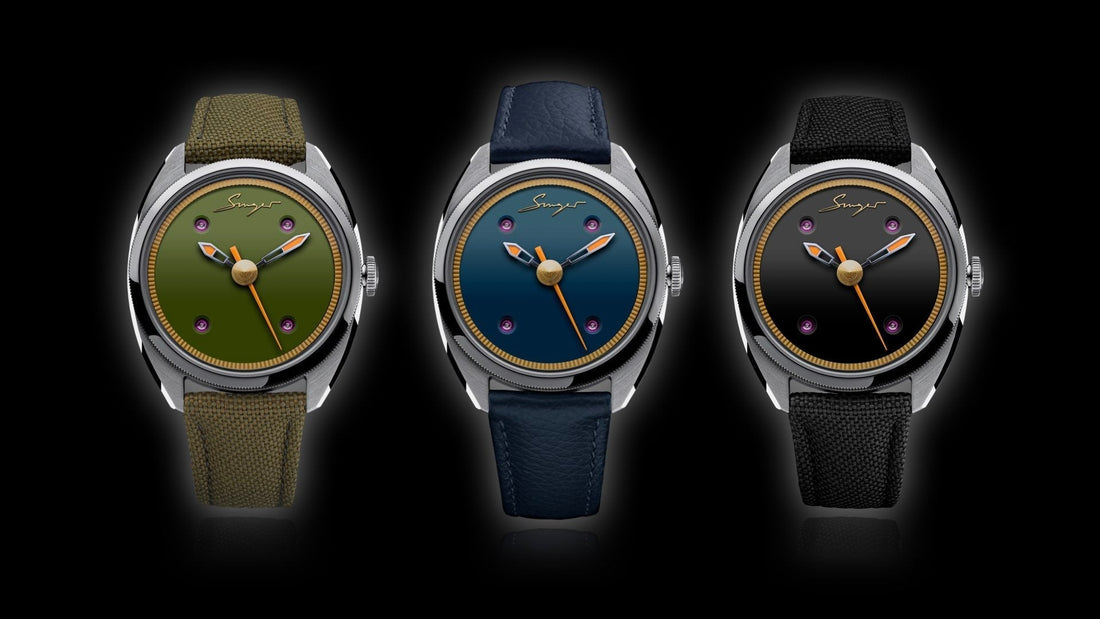
First Look at the All-new Singer Reimagined Caballero – Piano Black, Empire Green and Petrol Blue Watch Review
Share
A Three-hander with Serious Engineering
Singer has built its reputation on unconventional mechanics—center-display chronographs like the Track1 and concept-forward pieces like the DiveTrack. The Caballero is the brand’s first daily watch: conventional in function, proprietary in engine, and intended as a platform for future complications built on the same stability-first principles. For collectors who admired Singer’s ingenuity but wanted a slimmer, simpler daily wear, this is the door in.
More specifically, the Caballero is a stainless-steel, 39 × 10.5 mm three-hander that debuts the brand’s first fully proprietary movement, Calibre-4 Solotempo (ST5000). The case is deliberately slim, with a domed sapphire up top, a screwed sapphire display back, and 50 m water resistance; the lacquer dials come in Piano Black (SR701-1), Empire Green (SR701-2), or Petrol Blue (SR701-3) and are framed by Singer’s signature toothed golden flange. Discreet dial apertures hint at the movement beneath via the red cabochons of the four barrels.

Movement
Calibre-4 Solotempo is a hand-wound architecture built for stability of rate over time. Its most distinctive feature is a twin set of double barrels. This four-barrel topology is designed to flatten the torque curve across the entire six-day (144-hour) reserve, minimizing amplitude drop as the mainsprings unwind and supporting chronometric consistency from first hour to last.
Multiple-barrel architectures aren’t new, but how they’re combined matters: pairing barrels in series increases autonomy; running pairs in parallel reduces torque variation. Calibre-4 does both—series for duration, parallel for stability—then runs the barrels fast to keep the delivered torque as flat as possible across the reserve.

Let's break it down. Calibre-4 uses four mainsprings to control how power leaves the barrels. Two barrels are first coupled in series on each side; that makes each pair behave like one longer, “softer” spring. A softer equivalent spring delivers a gentler, flatter torque as it unwinds and rotates farther for the same load—good for extending autonomy and smoothing the power slope. Then the movement joins those two series pairs in parallel. Parallel coupling adds their outputs together, restoring the torque headroom you’d lose if you only went “softer,” and it also averages out tiny differences between springs so the train sees fewer ups and downs. The net effect versus a single barrel is more stored energy overall and a steadier, more constant delivery to the escapement.

Singer also gears the barrels to run “fast,” meaning they turn more quickly relative to the rest of the train. Because power is torque times speed, spinning the barrels faster lets the movement supply the same downstream power with less torque at any given moment. Lower tooth loads reduce friction losses and make the watch less sensitive to the natural torque drop as the mainsprings unwind. Put together—the two-in-series, two-in-parallel layout plus fast-running barrels—you get a six-day, hand-wound three-hander that keeps balance amplitude in a tighter band across the reserve, with long, deliberate winding (many crown turns) as the only everyday reminder of the four-barrel architecture.
In practical terms, the movement runs at 4 Hz (28,800 vph), uses 33 jewels, totals 145 components, and takes roughly 109 crown turns from empty to full. Finishing is modern and restrained—rhodium-plated, finely micro-blasted bridges with diamond-cut bevels and engraved barrel and winding bridges—on a movement measuring about 34.20 × 4.83 mm.
 Wrist Size: 6.75 in / 17 cm.
Wrist Size: 6.75 in / 17 cm.
Case & Wearing Experience
At 39 mm in diameter and 10.5 mm thick, the Caballero wears compact and low-profile. A domed sapphire with double-sided AR caps the front, while a screwed sapphire back shows the new calibre; water resistance is 50 m. Circular satin on the case with polished chamfers keeps it crisp on the wrist without flash. Lug-to-lug is approximately 45 mm, making it sit easily on most wrists.

Dial & Hands
The multi-layer lacquer dial carries an applied Singer logo and the golden toothed flange. Subtle apertures reveal the barrel jewels beneath—an elegant mechanical tell. Rhodium-plated hour and minute hands receive orange Super-LumiNova for low-light legibility; the central seconds runs in Singer Orange capped by a golden cabochon. Colorways are Piano Black, Empire Green, and Petrol Blue.

Straps
Straps include deep blue-grained leather, khaki-green textile, or black textile, each tapering from 20 to 16 mm and paired to a steel pin buckle with a satin face, polished chamfers, and engraved logo.

Final Thoughts & Availability
For a brand that's synonymous with chronographs, the Callabero manages to strike out in an entirely new direction, yet still feel unmistakably at home. Of course, Singer's design cues are front and center, but so too is their approach to watchmaking—backing up their creation with an unusual, interesting and high-end movement. In this case, however, the caliber is their own.
The Singer Reimagined Caballero collection is available to order from Collective. Get in touch with us anytime to place your order. And as always, thanks for reading and supporting independent watchmaking.
